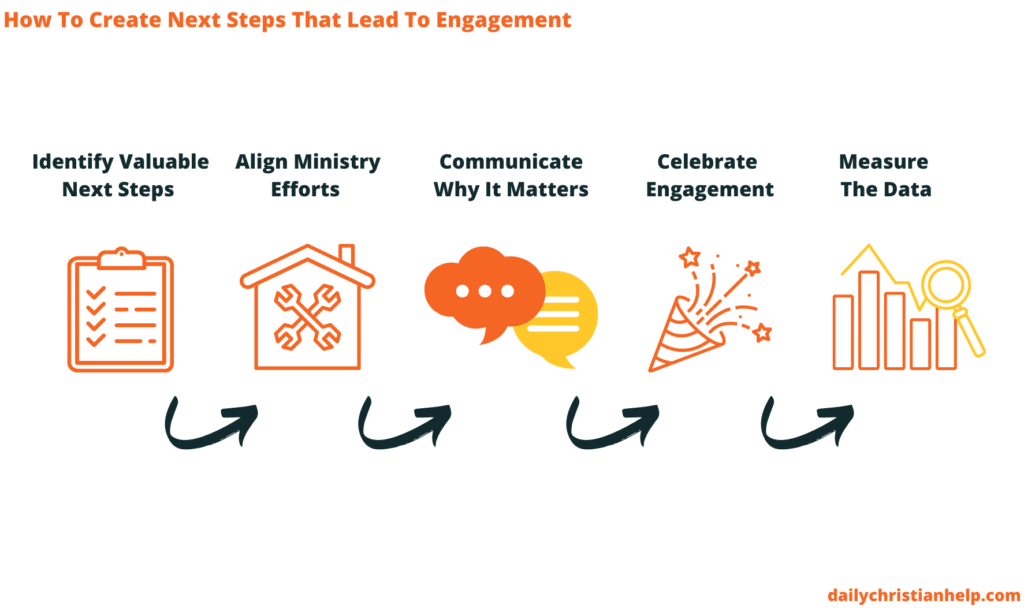Attending a service is just one step people take when engaging with your church. Helping people assimilate into your church and take the next steps toward deeper discipleship with Jesus is the call of every church leader.
What Are Church Next Steps?
Church next steps are intentional actions that individuals can take to further engage in their faith. Churches that encourage next steps can actively support the spiritual formation in others by helping facilitate responses that lead to deeper faith, maturity, and relationships.
The right next step for people at your church depends on their engagement level with God and your church.
Every person in your church is at a different place in their walk with God and other believers. This need can feel overwhelming, but the answer is not in offering as many ministries as possible. The key to helping individuals take the next steps is identifying the ministries that facilitate opportunities for appropriate next steps.

How To Define, Support, & Measure Next Step Strategies At Your Church
To get serious about helping people take steps, your team must agree on what action you want to help people consistently take. Defining which steps you want your church to help people take will help you prioritize effort and resources to support those steps.
- Which Next Steps Do You Want To Foster?
- What Systems Can Support Each Step?
If you want to help people deeply engage with their faith, you must define, support, and measure the next steps that you encourage. Doing so provides clarity for the people in your church and your team.
3 Benefits Of Providing Next Steps For People At Your Church
- Church Next Steps Are Definable
- Next Steps At A Church Are Actionable
- Next Steps Are Measurable
Defining the next actionable and measurable steps will help your team assess which efforts need attention. You may find that there are some things that your church has been doing for years that you no longer want or need to prioritize.
When you try to make everything awesome, nothing can be.
As leaders, you must clarify what is most important so that your team knows what to focus on and your church understands what steps to take next.
Plus, using the language of “next steps” within your church fosters a discipleship and growth mentality. The idea is that every person has room to grow and that there is always a possible next step that can lead to deeper engagement with God, their calling, and the Body of Christ.

1. Create A List Of The Next Steps Your Church Wants People To Take
There will be many next steps that your church can support. The list can look like this:
- Follow Jesus
- Water Baptism
- Join A Small Group
- Attend A Service
- Serve By Volunteering
- Give
- Attend A New Believers
- Share Their Faith
- Read The Bible

2. Align Ministry Effort To Support Next Steps
Identifying the next steps that you hope people will take by engaging with your church and aligning effort will help clarify your church’s mission. If you are unclear about your mission, so are your church members. Check out the post: How To Clarify Church Mission Statements In 5 Easy Steps, if you need help.
If you want people to be passionate about the central mission of your church, only do programming that directly advances the central mission. – careyniuewhof.com
Many churches offer programs run by individuals who are more passionate about their ministry than the overall mission of the church that is supporting the program.
To create alignment, you must identify, prioritize, and communicate the action people take to engage in the next step.
After clarifying what priorities are most important, you can begin assessing every effort by asking two simple questions:
- Why Are We Doing This?
- How Does This Effort Support Or Take Away From What Is Most Important?
You may find that there are programs and communication that are draining effort. Aligning ministry priorities may require a few difficult conversations with ministry leaders to explain why.
Unifying ministry efforts may require serious overhauling of your current model and communication. The model you use can change to most effectively support the church next steps that best help individuals experience growth and discipleship.
3. Consistently Communicate Why Next Steps Are Important
If your church decides to shift from a program-based ministry to a mission-focused model, do not eliminate longstanding programs immediately or prematurely communicate without first laying a solid foundation for why a shift is occurring. Navigating church transition is challenging, and you want people to experience the transformation with you.
Allow people to catch the vision of why aligning support to facilitate next steps is so valuable. Understanding and communicating the benefits will go along with your team, volunteers, and church members.
Once you’ve figured out the next step you’re going to promote, brainstorm how you will pitch it to people who have gone through the initial step. Provide a compelling call to action that shows them the benefit of taking this next step. – servehq.church
Those new to your church need to understand why next steps should matter. The goal is to encourage and inspire them toward action rather than beg or demand something.

4. Celebrate Engagement
Concerning church next steps, engagement is the win. Apply the adage, celebrate the behavior that you want to be repeated. Always honor the wins in meetings, privately, and from the stage.
It’s easy to settle into old habits or to go through the motions as leaders, celebrating engagement does several things to enhance the organization:
- Lets The Team Know Effort Is Not Unnoticed
- Communicates What Is Important
- Inspires Others To Take Action
Celebrating the next steps that your team supports and that people take action toward reinforces your church’s value on engagement.
5. Measure Data To Assess
Once you define what next steps are the most important, you can begin to accumulate data concerning each step to help you assess and evaluate the effort, communication, and engagement.
You must have a target to measure if you want to increase the number of water baptisms, volunteers, salvation responses, conference sign-ups, etc. To create a measurable goal:
- Assign A Target Number
- Build A Process To Support The Step From Start To Finish
- Measure The Data Compared To The Target Number
- Assess Process For Dropoffs Or Bottlenecks
- Improve Process To Support More Next Steps
Analyzing the effort your team puts forth to the response rate of those you are calling to take action will help you understand where to improve the process to facilitate more next steps.
Church Next Step Examples
Below are several scenarios of different next step opportunities within a church. Use these examples to help you generate ideas for the next steps your team should prioritize and how you can best support engagement.
Next Steps for Those New To Your Church Online Or In-Person
A next step for people that are new to your service could be to capture the contact information so that you can stay in touch and continue to build a relationship with the individual.
There have to be specifically defined steps for those people who are new attendees in-person or online. Without specific and intentional steps, you will have disengaged people who eventually fall out of church due to a lack of community and connection. Below is a step-by-step process for how you can engage newcomers or visitors.
1. Capture Contact Information During Church Announcements
Use a lead magnet to offer a valuable resource in exchange for their information. Gathering an email or phone number, so you have the means to connect and regularly check up on newcomers is a great asset. You don’t want to bombard them with outreach; however, a respectful cadence can help build a trusting relationship that shows the church cares.
2. Next Utilize Follow-Up Tools To Stay In Touch
Email Marketing
Email is highly underrated in the church. Email is still one of the most preferred and effective means of communication. An email address is more valuable than a like, follow, or friend request on social media. Read this post to learn Why Churches Should Use Email Marketing Strategies.
Church Texting Services
Like an email address, a phone number allows you to send an initial message thanking them for their visit or send simple reminders of upcoming events. To learn more about using SMS text messaging at your church, check out the post: 10 Practical Ways Church Texting Services Can Improve Communication With People.

Next Steps for Those Who Attend Your Church But Do Not Volunteer Or Participate
There are several next steps to offer those who attend your church but experience little to no engagement. Inviting them to attend or participate in low-commitment opportunities can inspire further involvement.
Attend A Discovery Class
Your church needs to establish a reasonable next step, similar to Growth Track, that allows people to ask questions and resolve any hesitancy about further involvement.
Providing a low-pressure opportunity for individuals to learn more about your church’s vision, ask questions, and discover ways to become more involved is a great next step to encourage newcomers to attend.
Attend A Small Group
Small groups are excellent ways to experience community and spiritual growth. Recommending the right small group to disengaged members could be the invite they’ve been waiting for to find a group of people they can know, like, and trust.
Volunteer At An Event
Volunteering at an event rather than being a part of a team is less intimidating and more manageable for people who have busy schedules or are hesitant to engage. Allowing people to become familiar with volunteering at one-off events can build a hunger for serving others.
Next Steps After Salvation Experiences At Your Church
There are multiple ways to help new believers experience growth and maturity in their faith. New believers need support, encouragement, and opportunities to learn more about a relationship with God.
Below are several next steps that your church can help facilitate for new Christians and the benefits or purposes that each step can serve.
- Water Baptism (Commitment and Declaration of Faith)
- Spiritual Formation & Practices (Prayer & Bible Study)
- Small Groups (Friendship and Community)
- Volunteering (Service Unto Others)
New steps do not have to be big steps; even small steps in the right direction can lead to tremendous growth.
Church Next Steps Are Key To Continued Engagement
Next steps at your church should help people grow in their relationship with believers and God. Defining next steps at your church can help people decide how to further engage and clarify for your team which ministry efforts are the most important to prioritize.
Increasing engagement within your church is more than getting people to attend a service or sign up for a class. Engagement is an indicator of a more profound work within your church and the hearts of those involved. Church next steps are a vital aspect of discipling people and helping them experience s deeper connection with God and the Body of Christ.



